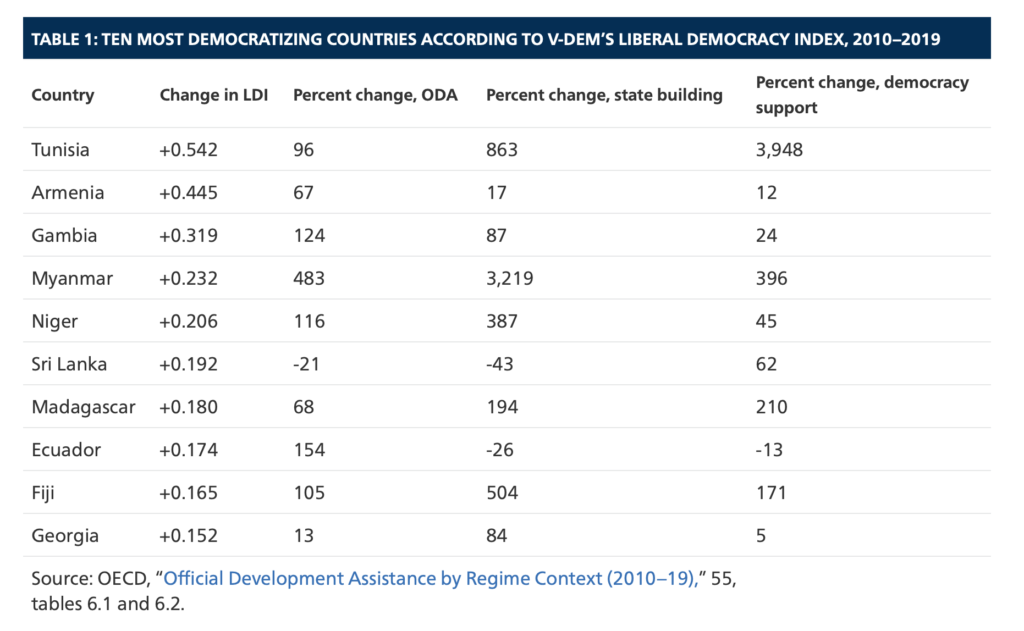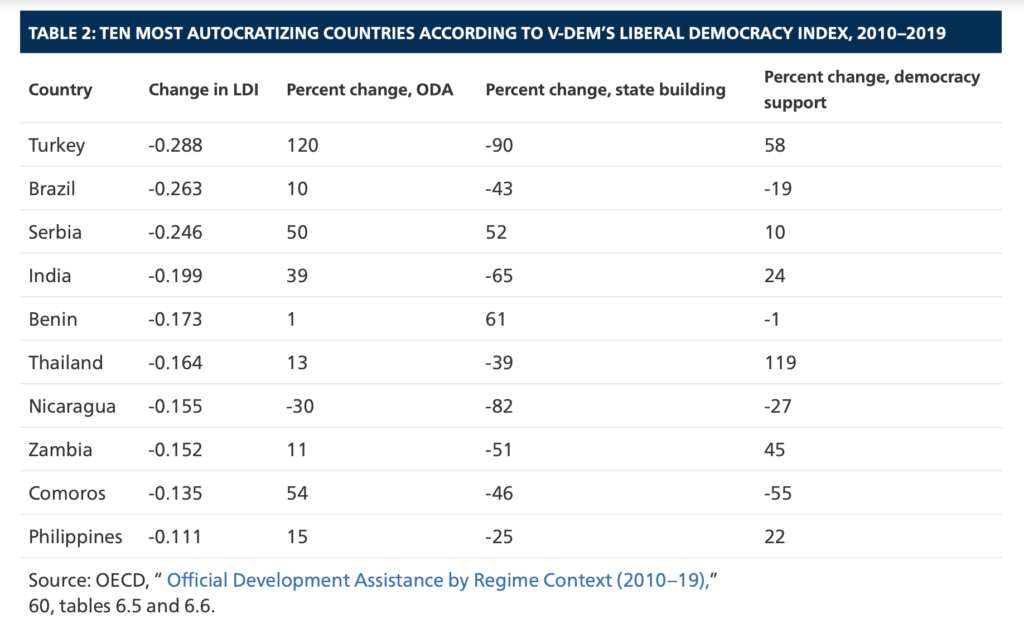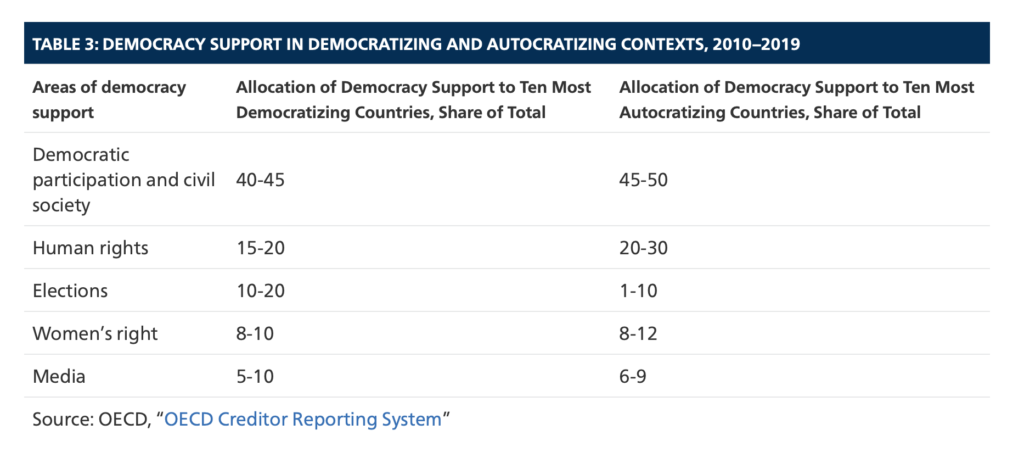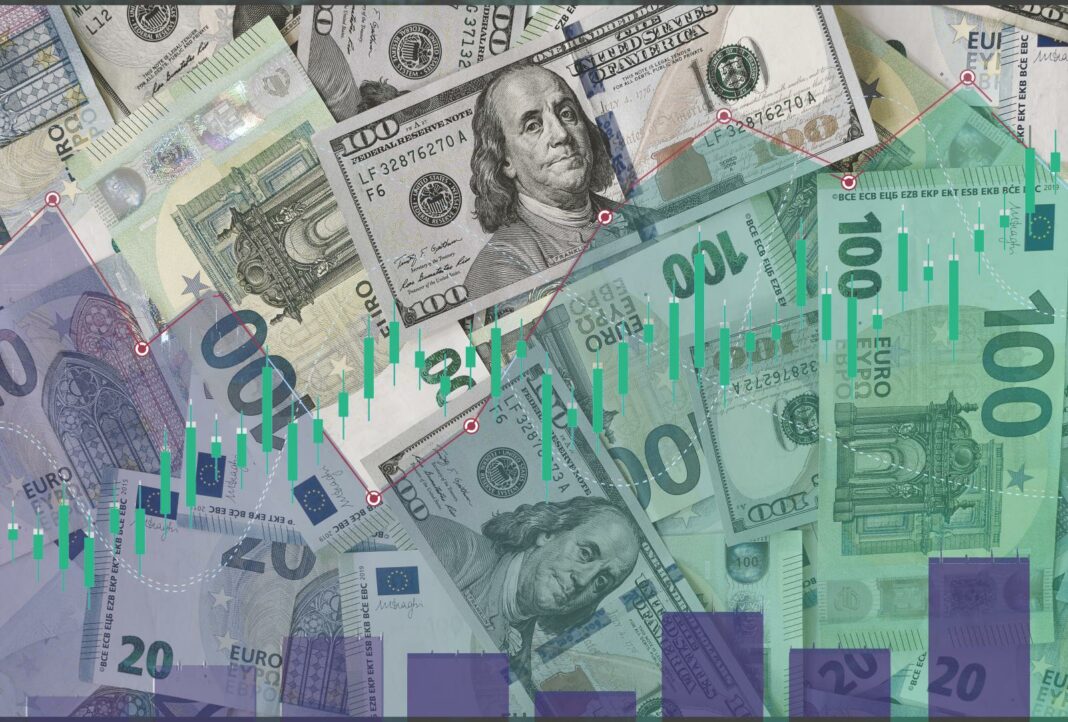« In the last decade, nondemocratic regimes have received more development assistance than democratic countries. This reveals how donors struggle with autocratization despite a rhetorical commitment to democracy » reports Marc De Tollenaere in Carnegie Europe.
Over the last decade, the pendulum has swung away from democratic governance toward autocratic rule, and donors have grappled with how to respond. While many countries are formally committed to supporting democracy, there does not seem to be a well-considered, strategic approach to addressing the trend of autocratization. According to a study by the Organization for Economic Co-operation and Development (OECD), a higher share of the official development assistance (ODA) provided by Development Assistance Committee (DAC) members and non-DAC donors goes to countries classified as autocratic than countries classified as democratic. In 2019, a striking 79 percent of ODA went to autocracies, up from 64 percent in 2010, mainly due to the increased number of countries classified as autocratic.1 And over this period, regime type did not appear to be a factor in the kinds of ODA allocations made across different political regime contexts. Donors have increased their ODA overall, but in addition to going to countries experiencing clear political openings, there were also increases to countries where governance has turned more autocratic—although less so in the area of governance support. These findings invite deeper reflection from donors on how to engage in different political regime contexts and how best to respond to varying governance trends.
METHODOLOGY
The DAC’s Network on Governance (GovNet) examined the ODA provided to different political regime contexts by DAC and non-DAC donors for the period 2010 to 2019. GovNet looked at both ODA flows overall and, more specifically, ODA to governance support. It analyzed aggregate ODA allocations by regime context; the kind of support donors provide to different regime types, including through what sectors and delivery channels; and donor responses to democratization and autocratization, including changes in the volume of funding provided and how it is delivered. Sources for the analysis included the OECD’s Creditor Reporting System (CRS) and the Variety of Democracy’s (V-Dem) Regimes of the World classification system. For the purposes of the analysis, governance support was divided into areas that strengthen state institutions and those that promote democratic governance.
Three significant findings emerged from the data, with challenging implications for international democracy support.
AUTOCRATIC COUNTRIES INCREASINGLY RECEIVED ODA
ODA is increasingly being disbursed in countries classified as autocratic (from 64 percent in 2010 to 79 percent in 2019, as noted above). There are two significant reasons for this. First, of the 124 ODA recipient countries and territories examined, the number classified as autocratic rose from sixty-eight in 2010 to seventy-five in 2019. This was mainly due to countries backsliding from an electoral democracy to an electoral autocracy. Second, the ODA to countries classified as closed autocracies sharply increased (178 percent; see figure 1). This was primarily due to a nineteen-fold rise in humanitarian aid to closed autocracies experiencing prolonged conflict (for example, Somalia, South Sudan, Sudan, Syria, and Yemen). A large share of this increase in humanitarian aid comes from non-DAC donors such as Saudi Arabia, Türkiye, and the United Arab Emirates. Other reasons include the reclassification of Syria and Yemen—top aid recipients—as closed autocracies in 2013 and 2016, respectively, and the tripling of ODA to Jordan (mainly increases in social sector support and humanitarian aid).
Figure 1. Country ODA Flows From All Official Donors, 2010–19

Source: OECD, “Official Development Assistance by Regime Context (2010–19),” 21.
The amount of development assistance under the electoral autocracy category grew because several large ODA recipients were reclassified from an electoral democracy to an electoral autocracy. India, Mali, the Philippines, Tanzania, and Türkiye particularly stand out. But also notable are the substantial increases in ODA to existing electoral autocracies like Bangladesh and Ethiopia. Electoral democracies received less development assistance overall, partly because of the reclassification of several regimes as electoral autocracies but also, though to a lesser extent, because of cuts in ODA to countries like Indonesia and Liberia. In 2019, only two out of the 124 countries considered in the ODA analysis were classified as liberal democracies: Costa Rica and Ghana.
Governance support was also predominantly delivered in autocratic contexts, rising from 65 percent in 2010 to 73 percent in 2019. The largest increase in ODA to governance was seen in closed autocracies (150 percent between 2010 and 2019). Afghanistan, an electoral autocracy, received 21 percent of governance support in the decade under review, and as of 2016, Jordan was receiving almost half of all ODA to governance support in closed autocracies. Also noteworthy is the sharp increase of sector budget support in closed autocracies, the majority of which went to Jordan in 2019 (76 percent). Starting in 2017, sector budget support became the dominant instrument to deliver ODA in countries classified as autocracies.
The sharp rise in ODA disbursed in autocratic contexts is disquieting, but with the exception of Jordan, it is not the result of donor decisions to increase support to autocracies but rather the result of trends toward more autocratic governance in several partner countries and the increase in humanitarian crises.
REGIME TYPE DOES NOT INFLUENCE ODA ALLOCATIONS
The volumes of ODA differ from one regime type to the other, and there are notable differences in humanitarian aid, with the share of humanitarian assistance as a share of total ODA decreasing across the autocracy-democracy continuum. However, this is not the case for the sectoral components of ODA for other development sectors, where there is surprisingly little variance across different political regimes. From 2010 to 2019, around half of development assistance (excluding humanitarian aid) across the different regime types went to “social infrastructure and services” primarily related to education, healthcare, water and sanitation, and governance. The share of ODA allocations to other sectoral categories was similar across regime types, too. Little variance is found in relation to the delivery channels of ODA as well. In countries classified as closed autocracies 59 percent of ODA was channeled through the public sector, in electoral democracies that was 56 percent, and in electoral democracies it was 64 percent.2 Eleven percent of ODA was channeled through civil society and NGOs in countries classified as closed autocracies and electoral democracies. However, there was higher use of multilateral delivery channels in autocratic contexts (20 percent in closed autocracies and 18 percent in electoral autocracies) than in democratic contexts (9 percent), potentially signaling an attempt by bilateral donors to take a collective approach.
There is also little variance when looking at the instruments of ODA delivery used over the ten-year period. In countries classified as closed autocracies, 68 percent of ODA was delivered through project-type interventions, and in electoral autocracies and electoral democracies it was 71 percent and 76 percent, respectively.
Overall, these findings seem to indicate that the regime context in which development cooperation takes place does not influence the choice of sectors supported, nor the channels or instruments used. Of course, broad development sectors such as “social infrastructure and services” can include a wide range of programs; many different interventions can be supported in, for example, the education or healthcare sector. Thus, it is not being suggested that development assistance is identical across regime types. Nevertheless, it is striking that the distribution of development assistance by sector is broadly similar across regime contexts.
Zooming in on governance support specifically, the picture is not any different. Over the period, and across the different political regime contexts, the distribution of ODA to state building (73 percent) and democracy assistance (27 percent) remained remarkably consistent. The volume of governance support changed over time, but the balance between state building and democracy support remained the same. In short, at the aggregate level, there is limited evidence that governance support is tailored to the specific opportunities or constraints of various political or regime contexts. Moreover, when looking at the distribution of the different purpose codes of democracy promotion, there are no significant differences among the kind of democracy support offered across closed autocracies, electoral autocracies, and electoral democracies (see table 1). In 2019, about one-third of democracy assistance went to “democratic participation and civil society” for every regime type. The proportion of ODA reported under the other purpose codes across different regime contexts was also similar that year (around 20 percent for human rights, around 12 percent for women’s rights, and around 5 percent for media).
The strong similarities among the sector allocations, instruments, and channels used to deliver ODA in countries with various regime types shows that regime type is not a key determinant of development assistance. This observation begs two questions: Why is this the case, and could ODA be delivered more effectively if it were better tailored to differing political regime contexts? It seems counterintuitive that ODA allocations for democracy promotion would be broadly similar across very different autocratic and democratic political contexts.
DONOR RESPONSE TO CHANGING REGIMES
Eighty out of 124 countries remained under the same regime type during the 2010–2019 period. Nine became more democratic, and twenty shifted toward a more autocratic regime type. Fourteen countries experienced a change in regime type during the decade but ended up back in the same regime classification by 2019. Importantly, some of the most democratizing contexts identified over the period, such as those in Myanmar and Tunisia, have experienced significant backsliding since then.
But even if a country remains classified within the same regime type, it does not mean that there are no movements in a more democratic or more autocratic direction. To measure change in a more granular way, GovNet looked at V-Dem’s Liberal Democracy Index (LDI) data over the ten years under review and analyzed donor responses to countries that gradually moved in a more democratic or autocratic direction, as well as countries that went through “critical junctures” (defined as those periods in which the LDI scores decrease or increase by 0.08 or more within a single year).
Out of the ten most democratizing countries during the period, as measured by the LDI, the majority saw increases in both overall ODA and ODA to governance (see table 1). Donor allocations to governance increased the most in Myanmar and Tunisia. The dissolution of the military junta in Myanmar was met with poignant and sustained international support. Overall, ODA increased fivefold from 2010 to 2019 and included a considerable increase in state-building investments. In Tunisia, the advent of the Arab Spring resulted in more ODA being given to governance support and democracy assistance. Total ODA to Tunisia only started increasing (rather modestly) in 2016, five years later. Despite these substantial ODA increases, the cases of Myanmar and Tunisia show how donor responses can be quite different in terms of the kind of support provided: governance support in Myanmar focused on state-building while funding in Tunisia focused on democracy support. Despite this assistance, however, both countries saw a return to autocratic governance. Interestingly, Sri Lanka improved its index score even though donors modestly reduced ODA there overall. The United States and the European Union provided the bulk of democracy support to these ten countries (24.1 percent and 20.8 percent, respectively). Australia, Germany, Switzerland, the World Bank, the United Kingdom, and the United States increased democracy support considerably to these countries over the decade.

Out of the ten most autocratizing countries during the period, nine saw a slight increase in ODA overall, but eight saw a significant reduction in state-building support (see table 2). Türkiye received the largest increase (120 percent) in ODA, while Nicaragua experienced a cut in ODA by 30 percent. In Thailand, Türkiye, and Zambia, there was a noteworthy bump in democracy support in response to gradual autocratization.

In short, the data indicate that ODA volumes do tend to change in countries where regime change happens, but the dimensions and speed of ODA responses differ. Democratization is generally rewarded with more ODA, while responses to autocratization show a more uneven pattern.
When comparing democracy support in the ten most democratizing countries with that in the ten most autocratizing countries, some differences can be observed, but the general trend is similar (see table 3). Donors invested more in human rights support in the autocratizing contexts and less in election support, but the relative share of other governance areas—like “democratic participation and civil society, media and free flow of information,” and “women’s rights”—were proportionally similar in both democratizing and autocratizing contexts. This tends to reinforce the finding that democracy support is not tailored to specific political contexts.

CONCLUSION
The study findings suggest that deeper policy discussions are needed on the ways in which donors and other actors engage in different regime contexts to protect and promote more open, democratic, and inclusive states and societies. The DAC remains committed to using development cooperation to support democracy, the rule of law, and human rights (including freedom of expression and peaceful assembly and association) as essential elements of sustainable development for any society. Yet the findings reveal that donors still need to resolve some policy issues in relation to this commitment. How can donors be better equipped to respond effectively to regressive or even hostile political regime contexts? How can they protect and support the needs of the poor, vulnerable, and disadvantaged in autocratic contexts, without reinforcing or strengthening autocratic regimes? How can they begin to tailor (parts of) ODA and governance support to political regime contexts?
The quantitative analysis summarized in this article does not establish a causal link between ODA and trends toward more democratic or more autocratic governance. Nor does it gauge the effectiveness or impact of ODA in different regime contexts; rather, it provides a big picture perspective of aggregate ODA allocations across them. As such, the analysis mostly contributes to the evidence base needed to inform the development of future policy and operational guidance for DAC members. It will be of further benefit when the forthcoming body of complementary, more qualitative assessments of ODA engagements in specific regime contexts is completed.3 Together, the quantitative and qualitative findings will help donors better understand the relationship between policy decisions and ODA allocations, instruments, and delivery channels across different regime contexts.
What is clear now is that development actors need to collectively and continually reflect on the role of ODA in the promotion of open, inclusive, and accountable states and societies globally.
Marc De Tollenaere is a Policy Analyst Governance in the Development Cooperation Directorate of the OECD, where he coordinates the Netwok on Governance of the Development Assistance Committee.
The article was written with support of Emile Boral-Rolland, edits from Catherine Anderson and under supervision of Frederik Matthys.
This article is part of the European Democracy Hub initiative run by Carnegie Europe and the European Partnership for Democracy.
Carnegie Europe, January 24, 2023, Marc De Tollenaere, Image/Sara Cuevas/TNH

